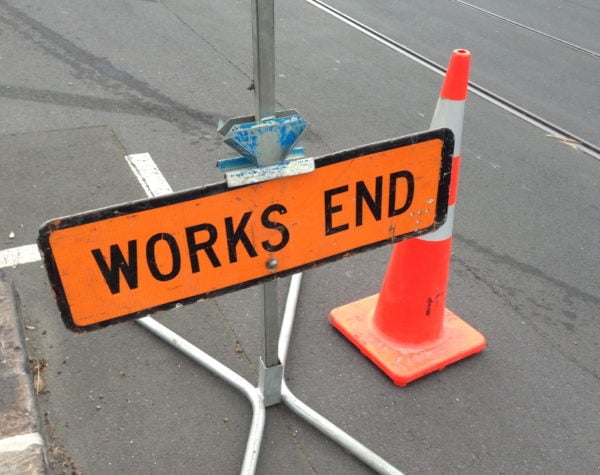Roadworks are areas of the road where either the road is being repaired, part of the road’s shoulder or road furniture is being repaired (e.g. barriers), or works are occurring on services such as water or power. They are usually demarcated using road cones or barriers. At road works, the speed limit will often (but not always) be reduced to either 30, 50 or 80km/h depending on:
- the characteristics of the road
- what work is being done
- how many people are working on-site
- how many vehicle movements are expected
- what impact there will be on other motorists.
Traffic Note 15 Revision 1 states that a temporary speed limit must be at least 20km/h less than the posted speed limit, not be in force for more than 6 months.
So, roadworks on a motorway which are separated by barriers and screens where there is good separation between workers and other traffic, and where works vehicles have space to exit and enter the motorway might only require a speed limit drop from 100km/h to 80km/h. However, if road works require one lane to be closed, the installation of traffic lights or traffic controllers with stop/go signs, and disruption to the road surface, the limit could be dropped to 30km/h. Minor roadworks on an urban side road might not require any speed limit change at all.
Why 30km/h?
Where road workers are close to moving traffic, there’s the risk of them being hit by vehicles and also flying debris – a stone in the eye is potentially life-changing (and not in a good way).
Around roadworks there’s often a lot of noise and workers are involved in their work, so it’s possible for a worker to not realise they are putting themselves in danger.
Rough roads are damaging to your vehicle if you drive too fast, so often there’s a practical reason for reducing the limit to 30km/h.
If there’s dust, then visibility is reduced.
Other road users like cyclists and pedestrians might be squeezed into a the same space as motorised vehicles.
If large machinery is involved (particularly tracked machinery like bulldozers), they can’t move fast, so create a speed differential on the road between regular road traffic and their top speed.
Why are speed limits still reduced even after roadworks are finished?
Roadworks often involve resealing work that leaves loose stones which are slippery and extremely dangerous to motorbike riders.
The road may need additional work to finish it off – sometimes, a pothole might be filled with a temporary repair until a permanent repair can be applied (this is often due to weather issues).
There may be hidden reasons that the speed limit needs to be reduced, such as the risk of further damage without additional repairs (e.g. subsidence).


